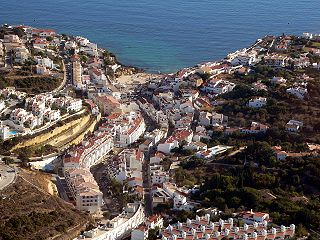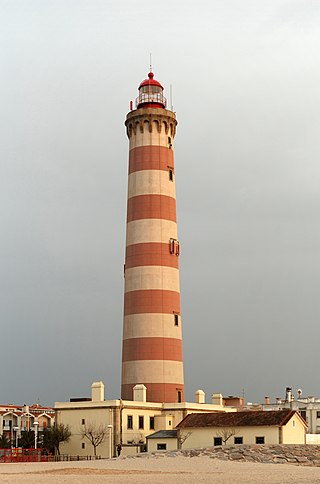
Carvoeiro is a town and a former civil parish in the municipality (concelho) of Lagoa, Algarve, Portugal. In 2013, the parish merged into the new parish Lagoa e Carvoeiro. The population in 2011 was 2,721, in an area of 11.66 km². It is located about 5 kilometres (3.1 mi) south of Lagoa.

Lagoa is a city and municipality in the district of Faro, in the Portuguese region of Algarve. The population of the municipality in 2011 was 22,975, in an area of 88.25 km2. Its urban population, in the city of Lagoa proper, is 6,100 inhabitants. An important travel destination, its coast has won numerous accolades. Marinha Beach was considered by the Michelin Guide as one of the 10 most beautiful beaches in Europe and as one of the 100 most beautiful beaches in the world.

The Lighthouse of Ponta da Barca is a beacon/lighthouse located along the 24 metres (79 ft) cliffs of Ponta da Barca, near the hamlet of Bom Jesus, civil parish of Santa Cruz da Graciosa on the island of the same, the Portuguese archipelago of the Azores. Immediately near the lighthouse, is the emblematic baleia de pedra, a curious geological basaltic rock that has resisted erosion, in the shape of a whale. The lighthouse includes a symmetrical single-floor building, and a 23-metre (75 ft) high cylindrical tower that extends its lamp to 71 metres (233 ft) above the ocean surface. It is considered a second-order lighthouse, which began operating on 1 February 1930.

The Lighthouse of Praia da Barra, also known as the Aveiro Lighthouse, is an active lighthouse in the civil parish of Gafanha da Nazaré, municipality of Ílhavo, in the Portuguese district of Aveiro. Situated on the coastal Praia da Barra, at the southern margin of the Ria de Aveiro, it is the tallest lighthouse in Portugal, with a height of 203 feet (62 m) overseeing the barrier beach and exposed to Atlantic storms. It is open to the public and visits are held on Wednesdays from 14:00 to 17:00.

The Ponta das Contendas Lighthouse is lighthouse located along the promontory of Contendas, in the civil parish of São Sebastião, municipality of Angra do Heroísmo on the island of Terceira, in the Portuguese archipelago of the Azores.

The Lighthouse of Ponta de Sagres, is beacon/lighthouse located along the coastal peninsula of Sagres Point in the civil parish of Sagres, in the Portuguese municipality of the Vila do Bispo.

The Lighthouse of Ponta Garça is a beacon/lighthouse located along cliffs of the civil parish of Ponta Garça in the municipality of Vila Franca do Campo, in the Portuguese archipelago of the Azores. The lighthouse was built in the 20th century, and consists of a circular tower and rectangular communications block, comparable to other lighthouses in the archipelago, namely Ponte do Cintrão and Ponta do Rosais.

The Ponta do Albernaz Lighthouse is a beacon/lighthouse located along the cliffs of Ponta do Albernaz in the northern parish of Ponta Delgada on the island of Flores, in the Archipelago of the Azores, Portugal.

The Lighthouse of Ponta Negra is a beacon/lighthouse located along the cliffs of promontory of Ponta Negra, in the municipality of Vila do Corvo, on the Portuguese island of Corvo, in the archipelago of the Azores.
The Lighthouse of Chibata is a multi-use structure water tower and lighthouse in the civil parish of Caparica e Trafaria, municipality of Almada, in the Portuguese district of Setúbal.

The Lighthouse of Cabo de São Vicente is a beacon/lighthouse located along the coastal peninsula of Sagres Point in the civil parish of Sagres, in the Portuguese municipality of the Vila do Bispo. Not to be confused with the Lighthouse of Ponta de Sagres, which is the located further to the edge of the extreme southwest cape of the civil parish, southwest of the Fortress of Sagres.

The Lighthouse of Vale Formoso is a beacon/lighthouse located along the southwestern cliffs of the civil parish of Capelo, in the municipality of Horta, on the Portuguese island of Faial, in the archipelago of the Azores.

Cabo Frio Lighthouse is an active lighthouse located on the southern point of the Ilha do Cabo Frio, called Focinho do Cabo, in the municipality of Arraial do Cabo, Brazil.

The São Julião Lighthouse is located in the fort of the same name, which is the largest sea defence structure in Portugal and is situated on a headland on the north bank of the River Tagus estuary in Oeiras, Lisbon District. It is a square masonry tower and the lantern is painted white, with a red dome.

The Ponta da Piedade Lighthouse is located at Ponta da Piedade in Lagos, in the Algarve region of Portugal. It started operations in mid-1913.

Cape Espichel Lighthouse is situated on the western coast of the civil parish of Castelo, municipality of Sesimbra, in the Setúbal district of Portugal. The lighthouse was built in 1790.

Berlenga lighthouse, also known as the Duke of Bragança Lighthouse, is a functioning lighthouse situated on the highest point of the granite island of Berlenga Grande, which is a nature reserve in the Atlantic Ocean, 10 kilometres west of the town of Peniche in the Leiria District of Portugal. Although planned for construction in the 18th century, work did not start until 1837 and it was completed in 1842.

The Fort of Cavalo Lighthouse is located in the Fort of São Teodósio da Ponta do Cavalo, on the western edge of Sesimbra, in the Setúbal District of Portugal. It started operations in 1896.

The Sines Lighthouse is located at Cabo de Sines, in Sines, in the Setúbal District of Portugal. It is a 22-metre high white cylindrical tower with a red beacon.



















